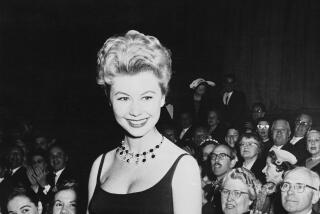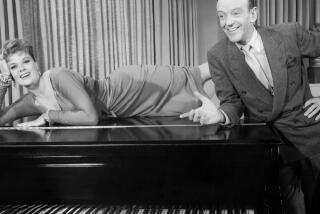Dolores Gray, 78; Stage and Screen Singing Star
Dolores Gray, the sultry, Junoesque singing star of such MGM musicals as “It’s Always Fair Weather” and “Kismet,” as well as Broadway and the West End stage, has died. She was 78.
Gray, who began singing professionally in Hollywood supper clubs at age 14, died Wednesday in her Manhattan apartment of a heart attack.
For the record:
12:00 a.m. July 11, 2002 For The Record
Los Angeles Times Thursday July 11, 2002 Home Edition Main News Part A Page 2 National Desk 21 inches; 763 words Type of Material: Correction
Gray obituary--A July 2 obituary of stage and film singer Dolores Gray incorrectly stated that she and her husband, Andrew J. Crevolin, were divorced. In fact, they were married when he died in 1992.
*
The young songstress had dabbled in clubs, radio, film and Broadway before she dazzled her way to the big time overseas in London’s West End in 1947. When legendary Ethel Merman, to whom Gray was often compared, decided not to portray “Two Gun Annie” when the show moved from Broadway to London, Gray became the historic sharpshooter, breaking all Coliseum theater records in “Annie Get Your Gun.”
The show ran two years and 11 months and was seen by more than 2.5 million people, including the king and queen and Princesses Elizabeth and Margaret. Previously unknown in Britain, Gray charmed the populace as well as her audiences and critics, one of whom described her voice as “warm brandy.”
“Dolores Gray brought a welcome touch of Hollywood glamour to drab postwar London,” noted the London Daily Telegraph in its obituary Friday, “and the newspapers chronicled with relish her colorful outfits, her hats, her crocodile skin handbags and her extravagance--how, for example, she had had her gray Persian cat, Scheherazade, brought over in its own cabin on the liner Queen Elizabeth.”
Success abroad guaranteed success at home. In 1954, Gray earned a Tony for her part in the short-lived musical “Carnival in Flanders,” memorably singing the Jimmy Van Heusen and Johnny Burke song that became a classic, “Here’s That Rainy Day.”
After a brief brush with Hollywood in her 1944 debut film, “Mr. Skeffington,” Gray was signed to a contract for MGM musical extravaganzas. She made four of them from 1955 to 1957--earning fifth billing in “It’s Always Fair Weather” after Gene Kelly, Dan Dailey, Michael Kidd and Cyd Charisse, and third billing in the 1955 version of “Kismet” after Howard Keel and Ann Blyth.
Gray ranked in the middle of a bevy of famous actresses in “The Opposite Sex,” a musical remake of “The Women,” after June Allyson and Joan Collins and before Ann Sheridan and Ann Miller. And she was third to the star couple, Gregory Peck and Lauren Bacall, in “Designing Woman.”
The singer appeared on several television variety shows in the 1950s, among them “The Milton Berle Show” and “The Ed Sullivan Show” and in tributes to such music men as Cole Porter.
She also recorded extensively for Capitol Records and was a popular cabaret singer, appearing in such nightspots as New York’s Copacabana and the Empire Room of the Waldorf-Astoria Hotel.
Her rich contralto voice occasionally graced the vast Hollywood Bowl, usually in salutes to the music of Broadway.
But Gray’s most prolific work was done on the stage. After her 1944 Broadway debut in “Seven Lively Arts” with Bea Lillie, Gray graduated to leading roles in such Broadway, West End and touring musicals as “Are You With It?”, “Two on the Aisle,” “Pygmalion,” “Can-Can,” “Silk Stockings,” “Lady in the Dark,” “The Pajama Game,” “The Unsinkable Molly Brown,” “Destry Rides Again,” “Gypsy” and “42nd Street.” She later led revivals of “Gypsy” and “Follies.”
Although she considered her voice “fragile” and said she had merely learned to amplify it, Gray was known for belting with the best. In addition to her Tony-winning “Here’s That Rainy Day,” she stopped shows with such songs as the title number of “Sherry” and in 1959 overrode the noise of firefighters battling a curtain ablaze as she sang “Anyone Would Love You” to Andy Griffith in “Destry Rides Again.” She was credited with keeping the 1,500-member audience calm until the fire could be extinguished.
Once Britons came to know Gray in “Annie,” she remained popular there. In 1963, she continued to delight them with her extravagances--such as bringing along 12 full-length mink coats to keep her warm and two bodyguards to protect them. “My mother said to me,” she explained, “ ‘It’s not a very happy life unless you make it very big.’ ”
Gray’s life began quite humbly. She was born in Chicago to squabbling parents who divorced when she was 2, and her father died when she was 7. Throughout her life she carried a bullet in her left lung, an inoperable wound suffered in the crossfire of a gang fight during her youth.
Brought to Hollywood by her mother, Gray initially trained to become a dancer, but soon switched to singing and found jobs in nightclubs until her tender age was discovered. Rudy Vallee had heard her, however, and featured her on his national radio broadcast when she was 15, opening doors to a brighter future.
Single most of her life, Gray had a loud and litigious engagement to an American oil tycoon in the early 1960s and then was married for nine years to California businessman and race horse owner Andrew Crevolin. That marriage ended in divorce.
Gray is survived by a stepdaughter, Joanne Kildare of Alamo, Calif.
More to Read
The biggest entertainment stories
Get our big stories about Hollywood, film, television, music, arts, culture and more right in your inbox as soon as they publish.
You may occasionally receive promotional content from the Los Angeles Times.










